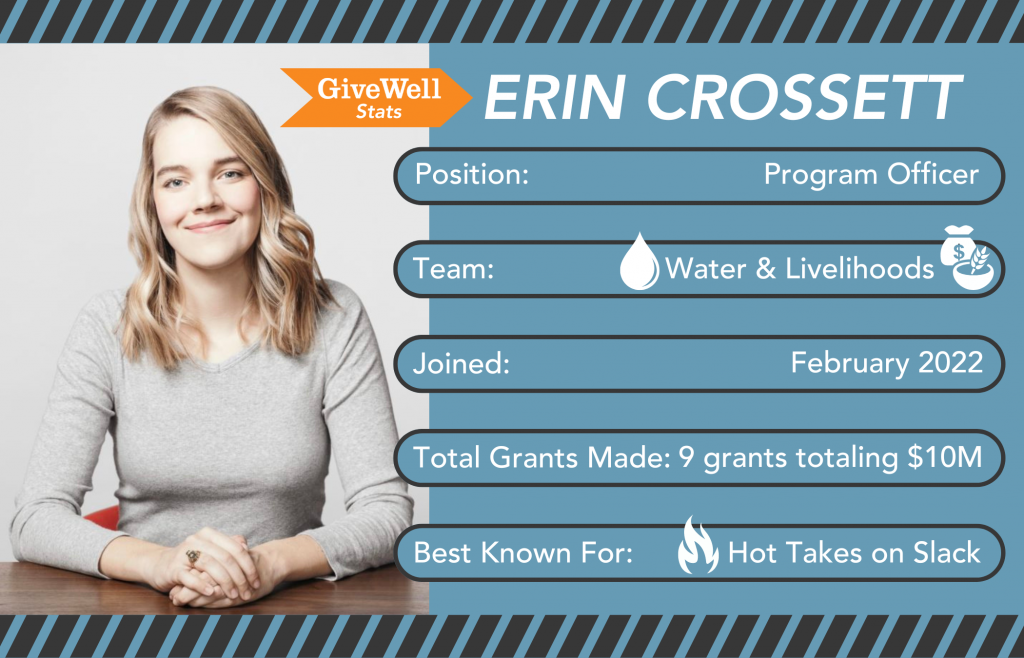Our research team spends over 50,000 hours a year looking for cost-effective organizations and interventions to save and improve lives, with the goal of producing the world’s top research on where to give. This interview with Program Officer Erin Crossett provides a glimpse into the world of GiveWell research.
Q: What made you interested in joining the GiveWell research team?
A: I really cared about working at a place where evidence of real impact was the key determinant of what we investigated and what we funded. I think a lot of organizations nominally care about impact, and the term “impact” gets thrown around a lot. But I think it really means something at GiveWell—it’s a core part of the GiveWell research DNA, and that’s very motivating.
Q: What grant are you most proud of contributing to during your time at GiveWell?
A: Actually the first grant I made at GiveWell: a grant to the Development Innovation Lab (DIL) at the University of Chicago to launch what we hoped would be a large, multi-site randomized controlled trial of water quality interventions. The trial was powered to detect mortality, looking at the effect of vouchers (coupons to redeem for free chlorine) and in-line chlorination (chlorine provided via an automatic dispenser added to an existing water pump) on all-cause mortality in children under five.
This grant was exciting for a number of reasons—it’s really rare to be able to run trials that are powered to detect mortality because it requires a really big sample size, and logistically, it’s quite complex to run a trial of that size. So the fact that we could do it, or even that we just took the first step to do it, is very exciting.
Before I joined GiveWell, a couple researchers on the team did a lot of work to make our first investments in clean water, but we were really uncertain about the effect of chlorination on all-cause mortality. This trial could reduce some of that uncertainty and potentially lead us to invest significantly more in water quality interventions. If the results are less promising than we thought, that could instead lead us to direct money to other interventions that are more cost-effective. So this research has real implications for how we direct large amounts of money. We would also learn more about the particular interventions themselves, which would help us better understand the effectiveness of chlorine vouchers versus in-line chlorination.
Q: What are you excited about, looking ahead for the GiveWell research team?
A: We’re increasing our focus on a “heads-up” approach to our work. Spending more time on ground truthing the model and talking to people who are familiar with the interventions we’re researching. Getting researchers to travel more, talking on the phone with implementers and governments more, understanding what we’re missing or could be getting wrong—these are concrete parts of the research process that our research team agrees we should be spending even more time on, and I’ve noticed a big shift in this direction since I joined two years ago.
Q: As a Program Officer, you have a small discretionary grant budget that you can recommend to opportunities that seem plausibly high-impact. What’s the most exciting small discretionary grant you’ve made?
A: Malengo is an organization that I’ve admired since it started, and I was really excited to recommend a small discretionary grant to them in January. The founder, Johannes Haushofer, is a really interesting person and an excellent researcher. He was involved in a lot of the early research on unconditional cash transfers, and he realized that migration is one of the most promising pathways out of poverty. He decided to launch Malengo, which is an educational migration program that supports students from low-income countries in moving to high-income countries for university.
We co-investigated the grant with Open Philanthropy, and we don’t fund many livelihood interventions1Livelihood interventions are programs that improve economic opportunities for beneficiaries.
(relative to health interventions), so it was a bit different from GiveWell’s usual grant. My hunch is that migration is one of the more promising livelihoods subfields, and I think there’s a lot of learning value for this grant for a relatively small amount of money. I’m really excited to see what comes of it.
Q: What’s the strangest fact you’ve come across during research of a program?
A: This came from the DIL grant I mentioned earlier. During a pilot of 10 in-line chlorinators in eastern India, we found that fewer people were drinking chlorinated water in Odisha than expected. We learned that in this particular area, there is a very popular staple dish made from fermented rice. Even a low chlorine dose inhibits the fermentation process and negatively affects the flavor of the dish.
Because of that, people in Odisha are pressuring the pump operators to shut off the dosers or to override the recommended setting to dose chlorine at a much lower level (below where you would expect health benefits to be realized). This gets back to the question about our research process—we’ve spent a lot of time investigating chlorination; we’ve read a bunch of studies; we’ve talked to a bunch of experts. But there are always unknown unknowns, and until you’re actually implementing the program and working with the local people who live this every day, you are just going to miss things that could be important to the bottom line.
So this is a sign that the research we’re funding is “working”—as part of a small-scale pilot to work out implementation kinks with in-line chlorinators, we learned more about the preferences of those we intend to serve, and how those preferences interact with the programs we fund.
Notes
| ↑1 | Livelihood interventions are programs that improve economic opportunities for beneficiaries. |
|---|

